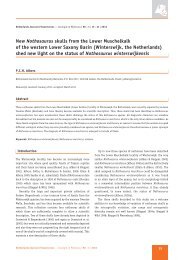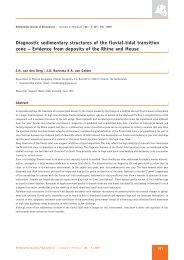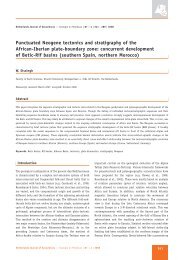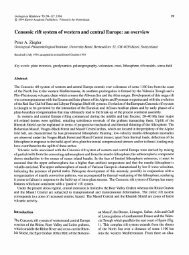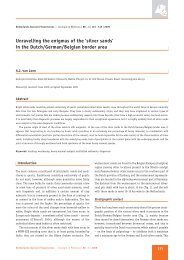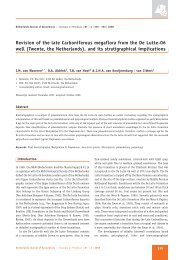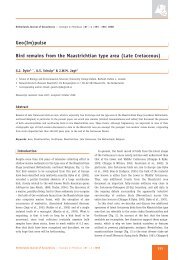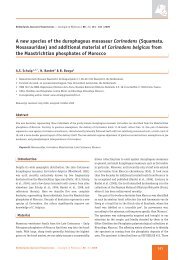Neotectonics of the Roer Valley rift system. Style and rate of crustal ...
Neotectonics of the Roer Valley rift system. Style and rate of crustal ...
Neotectonics of the Roer Valley rift system. Style and rate of crustal ...
You also want an ePaper? Increase the reach of your titles
YUMPU automatically turns print PDFs into web optimized ePapers that Google loves.
154<br />
Venlo marginal graben also indicates periods with local<br />
extension in <strong>the</strong> releasing bend. Such simultaneously<br />
operating processes in basin extension <strong>and</strong> flank uplift<br />
are important markers in <strong>the</strong> neotectonic evolution <strong>of</strong><br />
<strong>the</strong> stress regime.<br />
Stress-controlled geomorphology<br />
In Fig. 8a, <strong>the</strong> floodplain splits around a mid-graben<br />
non-deposition area within <strong>the</strong> graben. This floodplain<br />
separation is interpreted to represent a mid-graben relative<br />
high, bounded by flanking lows, In <strong>the</strong> <strong>Roer</strong>mond<br />
area, <strong>the</strong> <strong>Roer</strong> <strong>Valley</strong> Graben is also morphologically<br />
characterised by a persistent central high (with terraces<br />
= uplift) <strong>and</strong> two flanking fault-bounded lows.<br />
Both from <strong>the</strong> seismic lines <strong>and</strong> from <strong>the</strong> morphology<br />
we know that such a tectonic low in itself repeats<br />
such a relief pattern. This tectonically defined morphology<br />
shows a sequence <strong>of</strong> scales: <strong>the</strong> fractal-alike<br />
pattern that emerges shows a strong similarity with <strong>the</strong><br />
stress-responding differential flexural <strong>crustal</strong> motions<br />
at basin-wide scales in a tensional setting (Cloetingh et<br />
al. 1985). This sequence may suggest that <strong>the</strong> <strong>crustal</strong><br />
mechanics <strong>of</strong> a divergent strike-slip setting ope<strong>rate</strong> at<br />
a local, a regional <strong>and</strong> a basin-wide scale. The scale<br />
determines <strong>the</strong> nature <strong>of</strong> <strong>the</strong> bounding structures: faults<br />
or flexures.<br />
Shortly after <strong>the</strong> Rhine shifted to <strong>the</strong> east, <strong>the</strong> Maas<br />
also shifted out <strong>of</strong> <strong>the</strong> graben <strong>and</strong> slipped <strong>of</strong>f <strong>the</strong> tilted<br />
Peel Block towards its present position. The presentday<br />
surface <strong>of</strong> this series <strong>of</strong> ab<strong>and</strong>oned floodplains<br />
shows a well-defined deformation pattern, expressed<br />
as a low relief (1 to 2 m scale) <strong>of</strong> structural lineaments<br />
(Van den Berg et al. 1994). Figure 9 shows <strong>the</strong> rosediagram<br />
(cumulative length x orientation-class) <strong>of</strong> <strong>the</strong><br />
lineaments in <strong>the</strong> area. The orientations are consistent<br />
with <strong>the</strong> results obtained in an area east <strong>of</strong> <strong>the</strong> Viersen<br />
Fault (Plein et al. 1982).<br />
In accordance with <strong>the</strong> palaeogeography, <strong>the</strong> geomorphology<br />
indicates <strong>the</strong> ongoing right-lateral divergent<br />
strike-slip faulting due to block rotation over <strong>the</strong><br />
last 600 ka. This is <strong>the</strong> most recent pulse in a series.<br />
Plate-tectonic implications <strong>and</strong> discussion<br />
We identified a number <strong>of</strong> accelerations <strong>and</strong> decelerations<br />
(pulses) superimposed on a generally high-<strong>rate</strong><br />
tectonic phase since <strong>the</strong> last 3 Ma. There are indications<br />
from o<strong>the</strong>r parts <strong>of</strong> Europe that important physiographic<br />
changes tend to cluster around <strong>the</strong>se pulses.<br />
For example, near <strong>the</strong> Gauss-Matuyama magnetoboundary<br />
a thrusting pulse <strong>of</strong> <strong>the</strong> Jura mountains causes<br />
<strong>the</strong> connection <strong>of</strong> <strong>the</strong> Upper Rhine with <strong>the</strong> Swiss Alps.<br />
This has been identified in <strong>the</strong> heavy-mineral composition<br />
<strong>of</strong> <strong>the</strong> Rhine sediments (Boenigk 1982; Tebbens<br />
et al. 1995).<br />
The Alpine geodynamics are thought to be <strong>the</strong><br />
mechanical consequence <strong>of</strong> <strong>the</strong> Africa-Europe collision.<br />
The presence <strong>of</strong> intra-plate stresses provides<br />
a possibility to underst<strong>and</strong> a coupling between <strong>the</strong><br />
inter-plate dynamics <strong>of</strong> <strong>the</strong> two plates <strong>and</strong> <strong>the</strong> pulses<br />
observed in our study area. It is suggested here that <strong>the</strong><br />
relaxation interval between 1.5-1.2 Ma (Fig. 6) may<br />
be <strong>the</strong> consequence <strong>of</strong> an observed change in direction<br />
<strong>of</strong> <strong>the</strong> relative motion <strong>of</strong> <strong>the</strong> African plate. During a<br />
part <strong>of</strong> <strong>the</strong> Early Pleistocene this direction temporarily<br />
changed from northwest towards nor<strong>the</strong>ast; this is<br />
extensively studied in <strong>the</strong> Tyrrhenian arc <strong>system</strong> by<br />
e.g. Van Dijk & Scheepers (1994) <strong>and</strong> summarised<br />
by Scheepers (1994). From <strong>the</strong> same area Brogan et<br />
al.(1975) report a pr<strong>of</strong>ound change in <strong>the</strong> activity <strong>of</strong><br />
<strong>the</strong> Tyrrhenian arc about 1.1 Ma.<br />
Contemporaneously with this last event, uplift<br />
<strong>and</strong> consequent terrace formation begin in <strong>the</strong> central<br />
Appenines, Italy (Coltorti 1993), <strong>the</strong> Limagne, France<br />
(Allier river, Veldkamp 1991), on <strong>the</strong> north flank <strong>of</strong><br />
<strong>the</strong> Paris Basin (Somme river, Antoine 1993), <strong>and</strong> in<br />
<strong>the</strong> Bohemian Massif (W.H. Zagwijn, pers. comm.<br />
1993).<br />
The relaxation phase found between 600 <strong>and</strong> 430 ka<br />
shows a strong synchronism with phase 2 <strong>of</strong> <strong>the</strong> Eastern<br />
Eifel volcanic activity (Van den Bogaard & Schmincke<br />
1990). The o<strong>the</strong>r recognised phases in <strong>the</strong> Eastern<br />
Eifel volcanism are relatively short with respect to <strong>the</strong><br />
resolution <strong>of</strong> <strong>the</strong> changes in uplift <strong>rate</strong> registered by<br />
<strong>the</strong> Maas river record, although <strong>the</strong>re is synchronism<br />
between <strong>the</strong> last recorded relaxation phase <strong>and</strong> phase<br />
5 in <strong>the</strong> volcanic activity.<br />
Although this list <strong>of</strong> records is far from <strong>system</strong>atic<br />
<strong>and</strong> complete, <strong>the</strong>y suggest that <strong>the</strong> Maas terrace<br />
flight identifies a lithospheric signal <strong>of</strong> plate-tectonic<br />
importance.<br />
The coincidence <strong>of</strong> regional uplift <strong>of</strong> ancient structural<br />
domes <strong>and</strong> sinking basins, toge<strong>the</strong>r with <strong>the</strong> formation<br />
<strong>of</strong> pull-apart basins due to divergent strike-slip<br />
motions in response to forel<strong>and</strong> compression by <strong>the</strong><br />
Alps <strong>and</strong> <strong>the</strong> Rhenish Shield, may suggest that <strong>the</strong>se<br />
processes are controlled by important phases in <strong>the</strong><br />
plate reorganisation (Cloetingh & Kooi 1992).<br />
The observed accelerations in uplift from <strong>the</strong> Tertiary<br />
to <strong>the</strong> Pleistocene, in conjunction with <strong>the</strong> accel-



